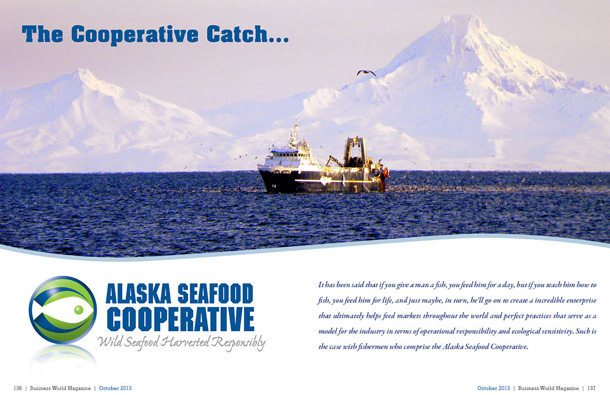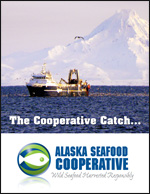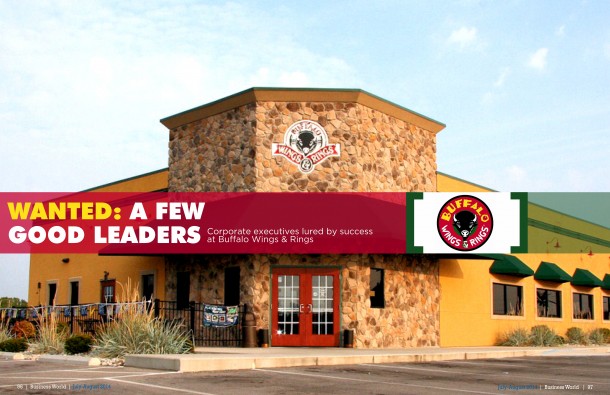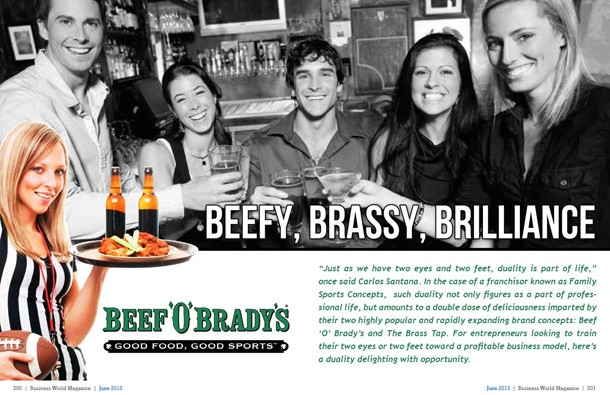
The Cooperative Catch

It has been said that if you give a man a fish, you feed him for a day, but if you teach him how to fish, you feed him for life, and just maybe, in turn, he’ll go on to create a incredible enterprise that ultimately helps feed markets throughout the world and perfect practices that serve as a model for the industry in terms of operational responsibility and ecological sensitivity. Such is the case with fishermen who comprise the Alaska Seafood Cooperative.
The Bering Sea encompasses more than two million square kilometers of Pacific Ocean territory bordered by Alaska, the Aleutian Islands, Russia and the Bering Strait that connects these waters to the icy tides of the Arctic Ocean. Below the surface, a deep-water basin rises through a narrow slope allowing the water to become shallower above the continental shelves. The interplay between the features of the sea floor, the currents, sea ice and weather systems all combine to accommodate a rich and remarkable ecosystem. Yet, it also accommodates rich and remarkable opportunities for fisherman that have long trawled these waters in pursuit of Pollock, Pacific Cod, Yellowfin Sole, and other species deemed succinctly succulent to seafood lovers. The waters off Alaska supply more than half of the total amount of wild fish annually supplied to markets throughout America. The competition between fisheries and among fishermen has prompted an annual, occupational rite-of-passage known as “The Race,†but over the years, has also generated concern relative to overfishing and adverse impact to sensitive ecosystems. To mitigate that impact, government agencies have imposed and enforced regulations to limit the catch of select species, which has had some success, but within this environment, there is one enterprise which has emerged as a best-practices model in fisheries management and environmental stewardship.
The Alaska Seafood Cooperative is comprised by five companies: Fishermen’s Finest, Iquique U.S., Ocean Peace, O’Hara Corporation, and United States Seafoods. Since coming together in 2008, these multi-species, “catcher processer†companies have advanced in a cooperative business framework which has not only proven to elevate operational efficiencies and improve management of Bering Sea flatfish, but has also advanced in solutions which decrease impact on the ecosystems that help drive the economics of this industry.
Prior to his appointment as Manager of the Alaska Seafood Cooperative, Jason Anderson served a regulatory agency which routinely tasked him as an observer aboard trawlers where he counted fish; duties essentially born of the government’s determination to impose quotas. Anderson actually helped design the operational framework and management structure which led to the creation of the cooperative. To explain the benefits of this model, Anderson shares insight on the disadvantages inherent in the old system. Anderson explains that in the race for fish, the government might open a target allocation with an associated prohibited species catch limit, usually halibut or crab, that are required to be discarded. The fishery would understand there were limits as to how much could be caught. Yet, for those who participated, there could only be focus on the indicated, allocated, species, as prohibited species were allocated to other target fisheries. In the course of fishing, the fishery might avoid capture of other species, but some are always caught (known as bycatch) which are required to be discarded. And upon reaching quota with respect to the species allocation or prohibited species catch limits, the fishing operations were brought to an immediate halt. It basically fostered a lot of competition and resulted in significant impact to species that were ultimately cast away when not part of the allocated species.
As Anderson says, “The system forced operators to fish in a manner that was competitive, a race to catch a certain species… and they used to throw away a lot of fish. The fishers would keep the most valuable fish and throw the others away. Prohibited species catch limits typically closed fisheries, not achievement of target species limits. It was also a difficult balancing act because each year, quota numbers would vary from species to species.†Anderson acknowledges that Alaska fishermen have traditionally been proactive in exercising particular care for the environment, as has much of the state, but the fact remains such care hasn’t always been the focus among other international firms.
In 2008, in an effort to end the “race for fish,†the North Pacific Fishery Management Council created a new system known as “Amendment 80.†This initiative ultimately divided groundfish target quotas and by-catch limits among newly formed cooperatives such as the Alaska Seafood Cooperative. Anderson says this management system makes each group responsible for its own catch and bycatch, and also provides strong incentive for the co-ops to keep by-catch rates low, improve the retention of groundfish, reduce halibut and crab catch, and fish cleanly and efficiently.
Anderson says there were challenges that formerly arose in the interplay between target species, groundfish bycatch and prohibited species catch (PSC) limits. “Prior to Amendment 80, the government assigned halibut and crab PSC amounts to target fisheries, which also had limits. The race was inefficient, and fisheries were mostly closed because of reaching PSC limits. Fisheries rarely achieved target limits and also threw away 50-60 percent of their target species. Under Amendment 80, we’re more efficient at avoiding PSC, and since 2008, we haven’t been shut down due to PSC limits. Rather, we either ran out of time or target quota.â€
As Manager of the cooperative, Anderson does not participate in the day to day operations of each member company, but helps direct communications and oversight to ensure that each remains compliant with regulations. As a multi-species fishery, the Alaska Seafood Cooperative has become internationally respected as a supplier of the varieties of sole and flounder, as well as
Atka mackerel, Pacific cod, Pacific Ocean Perch and more. AKSC members operate catcher-processors of 110 to 295 feet; each is equipped with the composite of implements to both process and freeze catch. AKSC members supply seafood to markets throughout North America, as well as markets in Asia and Europe.
Â
MSC Certified and Eco-Sensitive
The Alaska Seafood Cooperative’s operational practices have garnered distinction in earning certification by the Marine Stewardship Council (MSC). As an independent, non-profit organization, the MSC helps identify fisheries that operate in an environmentally responsible way, without contributing to the global environmental problem of overfishing. MSC certification requires a thorough review of the fishery through a transparent and systematic process and applied scientific principles which assess stock assessment methodologies, the measures it deploys to mitigate the environmental effects on target and by-catch species, and the manner in which the fishery affects ecosystems. Anderson says MSC certification helps distinguish the operational and environmental practices of flatfish fisheries of Alaska from the practices of other fisheries around the world. He also says some markets have grown increasingly conscientious in how they source seafood, actually looking to ensure suppliers have earned this certification.
As a further testament to AKSC’s environmental stewardship, one need only consider what it has achieved in terms of supporting groundfish retention. What was once calculated at 50 to 60 percent has now climbed to almost 95 percent, designating this enterprise among the best performing in the industry. “Our groundfish retention achievements are largely attributed to our developing of markets for previously discarded fish … also, by receiving cooperative allocations, each target fish became valuable,†explains Anderson.
AKSC has also advanced in methods of minimizing impact to eco-systems through its trawling processes. That achievement has been spurred in part by the manner in which AKSC has worked to minimize impact to eco-system through its trawling processes. Typically, a trawl sweep deploys a combination of wire and rope which help expand a net that skims just above the surface of the ocean floor. It not only herds fish, but without modification comes in contact with bottom dwellers and their habitats. Anderson says AKSC has demonstrated that by raising the trawl sweep by several inches, it doesn’t decrease the amount of fish that can be caught, but it does, however, significantly reduce the impact on the habitat below, in fact, by more than 90 percent. Members of the cooperative have also worked with scientists and net designers to modify their nets and this has helped to reduce the halibut by-catch.
In terms of the future, Anderson says the cooperative is striving to increase efficiencies to better achieve the full quota with respect to annual allocations, yet he says those efforts will be augmented by further advancements in sustainability and environmental stewardship – and no doubt, the cooperative nature of this company will continue to complement its capabilities.
For more information, please visit their website at: Â Â Alaska Seafood Cooperative
Preferred Vendors of Choice:








Thanks , I have recently been searching for info approximately this subject for
ages and yours is the greatest I have found out till
now. But, what about the conclusion? Are you certain in regards to the supply?
Comments are closed.